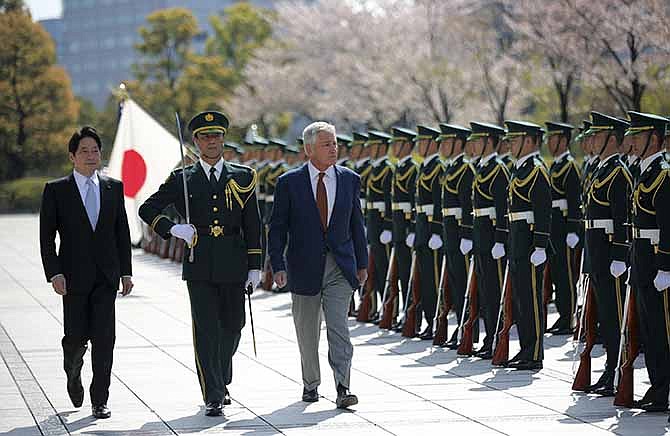TOKYO (AP) - The U.S. will deploy two additional ballistic missile defense destroyers to Japan by 2017 as part of an effort to bolster protection from North Korean missile threats, Defense Secretary Chuck Hagel said Sunday.
Speaking to at a news conference following a meeting with Japan Defense Minister Itsunori Onodera, Hagel said they discussed the threat posed by Pyongyang. He said the two ships are in response to North Korea's "pattern of provocative and destabilizing actions" that violate U.N. resolutions and also will provide more protection to the U.S. from those threats.
In unusually forceful remarks about China, Hagel called the Asian nation a "great power" and said that when he travels to China later this week he will tell its officials that they must have respect for their neighbors. Japan and China have been at odds over territorial claims and other issues.
"With this power comes new and wider responsibilities as to how you use that power" and how to employ military might, Hagel said, adding that he looks forward to an honest, straightforward dialogue with the Chinese.
The announcement of the deployments of additional destroyers to Japan came as tensions with North Korea spiked again, with Pyongyang continuing to threaten additional missile and nuclear tests. North and South Korea fired hundreds of artillery shells into each other's waters in late March in the most recent flare-up.
On Friday, North Korea accused the U.S. of being "hell-bent on regime change" and warned that any maneuvers with that intention will be viewed as a "red line" that will result in countermeasures. Pyongyang's deputy U.N. ambassador, Ri Tong Il, also said his government "made it very clear we will carry out a new form of nuclear test" but refused to provide details.
The two additional ships would bring the total to seven U.S. ballistic missile defense warships in Japan, and it continues U.S. efforts to increase its focus on the Asia Pacific.
Hagel is on a 10-day trip across the Asia Pacific, and just spent three days in Hawaii meeting with Southeast Asian defense ministers, talking about efforts to improve defense and humanitarian assistance cooperation. Japan is his second stop, where he said he wants to assure Japanese leaders that the U.S. is strongly committed to protecting their country's security.
Japan and China have been engaged in a long, bitter dispute over remote islands in the East China Sea. The U.S. has said it takes no side on the question of the disputed islands' sovereignty, but it recognizes Japan's administration of them and has responsibilities to protect Japanese territory under a mutual defense treaty.
Hagel said the U.S. wants the countries in the region to resolve the disputes peacefully. But he added that the United States would honor its treaty commitments.
Last October, the U.S. and Japan agreed to broad plans to expand their defense alliance, including plans to position a second early warning radar there by the end of this year. There is one in northern Japan and the second one would be designed to provide better missile defense coverage in the event of a North Korean attack.
The U.S. will begin sending long-range Global Hawk surveillance drones to Japan this month for rotational deployments. They are intended to help step up surveillance around the Senkaku islands, a source of heated debate between Japan and China over claims to the remote territories.
In its latest symbolic gesture of support for Japan, the U.S. decided not to send a warship to participate in a Chinese naval parade as part of the Western Pacific Naval Symposium because the Japanese were not invited. U.S. military leaders, including the Navy's top officer, Adm. Jonathan Greenert, will attend the symposium and ship review.
The ships serve as both defensive and offensive weapons. They carry sophisticated systems that can track missile launches, and their SM-3 missiles can zero in on and take out short- to medium-range missiles that might be fired at U.S. or allied nations. They can also carry Tomahawk cruise missiles, which can be launched from sea and hit high-value targets or enemy weapons systems from afar, without risking pilots or aircraft.

